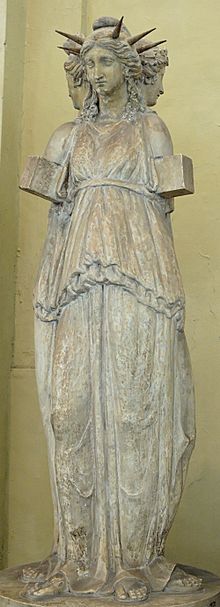
Back Hekate Afrikaans هيكات Arabic Hécate AST Геката Bashkir Hekate BAR Hecate BCL Геката Byelorussian Хеката Bulgarian হেকাতে Bengali/Bangla Hekate Breton
| Hecate | |
|---|---|
 The Hecate Chiaramonti, a Roman sculpture of triple-bodied Hecate, after a Hellenistic original (Museo Chiaramonti, Vatican Museums) | |
| Animals | Dog, polecat |
| Symbol | Paired torches, dogs, serpents, keys, knives, and lions. |
| Parents | Perses and Asteria |
| Offspring | Aegialeus, Circe, Empusa, Medea, Scylla |
| Equivalents | |
| Mesopotamian | Ereshkigal (used as an epithet in a late Greek magical text)[3] |
Hecate[a] is a goddess in ancient Greek religion and mythology, most often shown holding a pair of torches, a key, or snakes, or accompanied by dogs,[4] and in later periods depicted as three-formed or triple-bodied. She is variously associated with crossroads, night, light, magic, protection from witchcraft, drugs, and the Moon.[1][2][5] Her earliest appearance in literature was in Hesiod's Theogony in the 8th century BCE[6] as a goddess of great honour with domains in sky, earth, and sea. She had popular followings amongst the witches of Thessaly, and an important sanctuary among the Carians of Asia Minor in Lagina.[7] Her oldest known representation was found in Selinunte, in Sicily.
Hecate was one of several deities worshipped in ancient Athens as a protector of the oikos (household), alongside Zeus, Hestia, Hermes, and Apollo.[8] In the post-Christian writings of the Chaldean Oracles (2nd–3rd century CE) she was also regarded with (some) rulership over earth, sea, and sky, as well as a more universal role as Savior (Soteira), Mother of Angels and the Cosmic World Soul (Anima Mundi).[9][10] Regarding the nature of her cult, it has been remarked, "she is more at home on the fringes than in the centre of Greek polytheism. Intrinsically ambivalent and polymorphous, she straddles conventional boundaries and eludes definition."[11]
The Romans often knew her by the epithet of Trivia, an epithet she shares with Diana, each in their roles as protector of travel and of the crossroads (trivia, "three ways"). Hecate was closely identified with Diana and Artemis in the Roman era.[12]
- ^ a b Merriam-Webster 1995, p. 527.
- ^ a b Seyffert, s.v. Hecate
- ^ Schwemer 2019, p. 66.
- ^ Edwards, Charles M. (July 1986). "The Running Maiden from Eleusis and the Early Classical Image of Hekate". American Journal of Archaeology. 90 (3). Boston, Massachusetts: Archaeological Institute of America: 307–318. doi:10.2307/505689. JSTOR 505689. S2CID 193054943.
- ^ d'Este, Sorita & Rankine, David, Hekate Liminal Rites, Avalonia, 2009.
- ^ trans. M.L. West (1988). Hesiod Theogony and Works and Days. New York: Oxforx World's Classics. pp. vii. ISBN 978-0-19-953831-7.
- ^ Burkert, p. 171.
- ^ Panopoulos, Christos Pandion. "Hellenic Household Worship". LABRYS.
- ^ "Bryn Mawr Classical Review 02.06.11". Bmcr.brynmawr.edu. Archived from the original on 22 October 2013. Retrieved 24 September 2012.
- ^ Johnston 1990.
- ^ Henrichs, s.v. Hecate.
- ^ Green, p. 133
Cite error: There are <ref group=lower-alpha> tags or {{efn}} templates on this page, but the references will not show without a {{reflist|group=lower-alpha}} template or {{notelist}} template (see the help page).